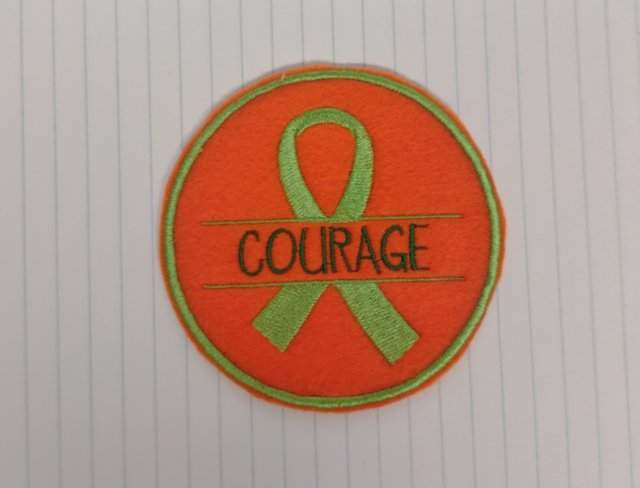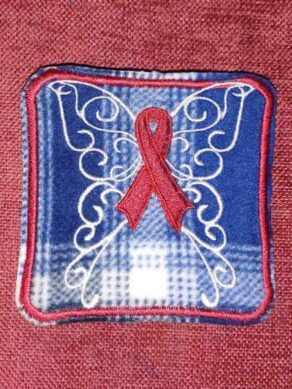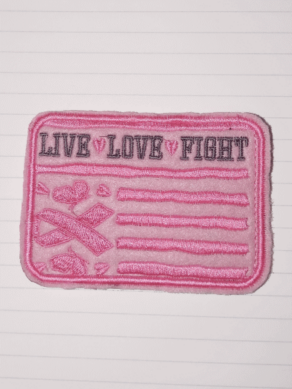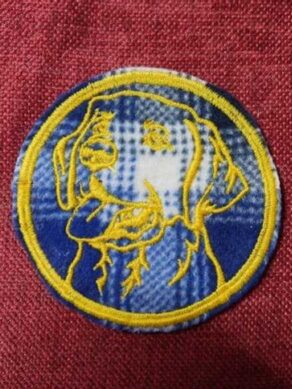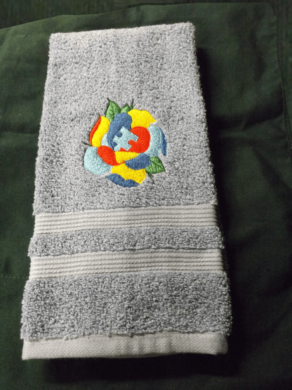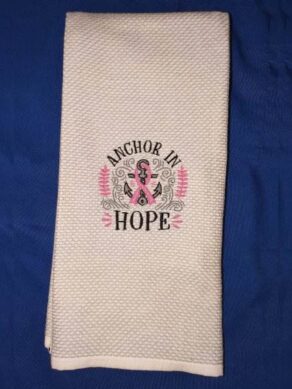Description
Lymphoma Awareness Ribbon Magnet – Courage
Lymphoma Awareness Ribbon Magnet – Courage on Orange Felt Fabric with Magnet Backing. The magnet is approximately 3½ inches in diameter, Not Machine Washable.
♥ ♥ ♥ ♥ ♥ ♥ ♥ ♥ ♥ ♥ ♥ ♥ ♥ ♥ ♥ ♥ ♥ ♥ ♥ ♥ ♥ ♥ ♥ ♥ ♥ ♥ ♥ ♥ ♥ ♥ ♥ ♥ ♥ ♥ ♥ ♥ ♥ ♥ ♥ ♥ ♥ ♥
Embroidered Magnet Care and Cleaning Guide
Cleaning embroidered items, especially those with magnetic backings, requires meticulous care to preserve their unique qualities and functionality. Here are detailed cleaning guidelines with 8 points of focus, to ensure the longevity and aesthetic appeal of your machine-embroidered products:
1. Spot Cleaning:
Spot cleaning is the initial and crucial step in preserving the pristine appearance of your machine-embroidered items on felt fabric with a magnetic backing. It’s the go-to method for addressing minor stains and spills promptly without subjecting the entire item to a full wash. Here’s a more detailed explanation of spot cleaning and why it’s vital:
• Prompt Action: The key to effective spot cleaning is prompt action. As soon as you notice a stain or spill on your embroidered item, don’t delay. The longer a stain sits, the more challenging it can be to remove, and it may even become set in the fabric.
• Gentle Approach: Spot cleaning is all about delicacy. Begin by selecting a mild detergent or a specialized stain remover designed for delicate fabrics. These products are less likely to damage the embroidery threads or the felt fabric.
• Blot, Don’t Rub: Instead of rubbing the stain, which can potentially cause the stain to spread or push it deeper into the fabric, gently blot the affected area. Use a clean, white cloth or a paper towel to blot from the outside of the stain towards the center. This method helps lift the stain without disturbing the delicate threads of the embroidery.
• Gentle Approach: Spot cleaning is all about delicacy. Begin by selecting a mild detergent or a specialized stain remover designed for delicate fabrics. These products are less likely to damage the embroidery threads or the felt fabric.
• Blot, Don’t Rub: Instead of rubbing the stain, which can potentially cause the stain to spread or push it deeper into the fabric, gently blot the affected area. Use a clean, white cloth or a paper towel to blot from the outside of the stain towards the center. This method helps lift the stain without disturbing the delicate threads of the embroidery.
• Testing in an Inconspicuous Area: Before applying any cleaning solution to the stain, it’s advisable to test it in an inconspicuous area of the item. This ensures that the detergent or stain remover does not adversely affect the embroidery or the felt.
• Multiple Applications: For stubborn stains, you may need to apply the cleaning solution multiple times. Always allow the area to air dry between applications. Avoid excessive scrubbing, as this can weaken the fabric and damage the embroidery’s intricate details.
• Rinse Thoroughly: After successfully treating the stain, rinse the spot thoroughly with cold water. This step is essential to remove any residue of the cleaning solution. Even mild detergents, when left behind, can attract dirt and dust, potentially leaving the area stiff and discolored.
• Additional Tips: When spot cleaning an embroidered magnet, remember to work with a steady hand and be patient. Rushing the process can lead to less effective stain removal and potential damage.
Spot cleaning ensures that minor stains and spills are dealt with promptly, preventing them from becoming permanent blemishes on your cherished embroidered items. It’s a gentle, targeted approach that helps maintain the impeccable appearance and intricate details of your machine-embroidered designs.
2. Hand Washing:
Hand washing is a gentle and effective method for cleaning machine-embroidered items on felt fabric with a magnetic backing. This approach ensures that you can clean your cherished items without subjecting them to the potential risks of machine washing. Here’s a more detailed look at hand washing and why it’s a recommended cleaning method:
Why Hand Washing is Preferable:
a. Delicate Handling: Hand washing allows for delicate and controlled handling of your embroidered item. Unlike machine washing, which can be rough on fabrics and embroidery, hand washing minimizes the risk of damage.
b. Temperature Control: Cold water is preferred for hand washing because it helps maintain the integrity of both the felt fabric and the embroidery threads. Hot water can cause the felt to shrink, and it may affect the colorfastness of the threads, potentially leading to fading or bleeding.
c. Preserving Embroidery: The primary goal when washing embroidered items is to protect the intricate embroidery. Hand washing ensures that the embroidery threads are not subjected to the mechanical stresses and abrasion that can occur in a washing machine. This helps maintain the vibrancy and detail of the design.
Steps for Hand Washing:
• Prepare a Gentle Detergent: Start by selecting a mild detergent specifically designed for delicate fabrics. Avoid using harsh detergents or bleach, as they can damage the embroidery threads and felt.
• Fill a Basin, Sink or Container: Fill a basin, sink or container with cold water. Add a small amount of the mild detergent and agitate the water gently to create suds.
• Submerge the Item: Carefully place the embroidered item in the soapy water, ensuring that it is fully submerged. Allow it to soak for a few minutes to loosen any dirt or stains. Be cautious not to heavily soak the embroidered magnet, as it could damage adhesive between the magnet and the embroidery fabric.
• Gentle Swishing: Gently swish the item around in the soapy water. Be cautious not to agitate it too vigorously, as excessive movement can lead to friction and potential damage to the embroidery.
• Rinse Thoroughly: After you’ve swished the item and are satisfied that it’s clean, remove it from the soapy water. Rinse it thoroughly under cold running water to remove all traces of detergent. Pay special attention to the embroidered areas to ensure no residue remains.
• Press Out Excess Water: To remove excess water, lay the item flat on a clean towel or a drying rack. Gently press it with the towel, rolling it up to absorb the moisture. Avoid wringing or twisting the embroidered fabric, as this can distort the design.
By following these steps for hand washing, you’ll ensure that your machine-embroidered items are cleaned with care and precision, preserving their unique qualities and allowing you to enjoy their beauty for years to come. Hand washing is a gentle and effective method that safeguards both the embroidery and the felt fabric, maintaining the integrity of your cherished items.
3. Avoid Soaking:
Prolonged soaking should be avoided when cleaning machine-embroidered items with magnetic backings. This guideline is particularly important because the magnetic backing is a unique and essential feature of your item, allowing it to adhere securely to metallic surfaces. Here’s why you should steer clear of prolonged soaking:
• Preserving the Magnetic Backing: The magnetic backing is designed to maintain its adhesive properties, ensuring that your item can be easily attached to metal surfaces. Prolonged exposure to water, especially if the water penetrates the backing, can compromise its adhesive capabilities. This could result in the magnetic backing losing some of its strength or effectiveness, making it less reliable for its intended purpose.
• Preventing Distortion: Soaking can also lead to distortion of the embroidered item. Felt fabric, while durable, can become heavy when saturated with water. This added weight, combined with the softening of the felt fibers during soaking, may cause the item to stretch or warp. Distortion could result in a misshapen or uneven appearance, detracting from the item’s aesthetic appeal.
• Maintaining Structural Integrity: Prolonged exposure to water can weaken the overall structural integrity of the embroidered item. The felt fabric may become more susceptible to tearing or fraying, and the embroidery threads could be at risk of loosening or unraveling. By avoiding prolonged soaking, you help maintain the strength and durability of both the felt fabric and the embroidery.
• Short Soaks for Spot Cleaning: While it’s important to avoid extended soaking, short soaks can be useful for spot cleaning. If you encounter a stubborn stain, you can immerse only the affected area in water for a brief period. This targeted approach allows you to address the stain without compromising the entire item’s integrity. After spot cleaning, be sure to rinse and dry the area thoroughly.
In summary, avoiding prolonged soaking is crucial to preserve the unique qualities and functionality of your machine-embroidered item, especially the magnetic backing. By following this guideline, you help maintain the adhesive strength of the backing, prevent distortion or damage to the felt fabric, and ensure the overall structural integrity of the embroidered item. This care and attention to detail will help your embroidered products remain both beautiful and functional for an extended period.
4. Rinse Thoroughly:
Proper rinsing is a critical step in the cleaning process for machine-embroidered items on felt fabric with a magnetic backing. It plays a pivotal role in ensuring the cleanliness and longevity of your cherished pieces.
• Detergent Residue Removal: One of the primary reasons for thorough rinsing is to eliminate any detergent residue. Even mild detergents, when left behind, can have detrimental effects on your embroidery and felt fabric. These residues can trap dirt and dust, creating a sticky film on the surface. Over time, this film can make the fabric stiff and unattractive, and it may even contribute to color fading.
• Preventing Stiffness: Proper rinsing is especially crucial for felt fabric. Felt is known for its soft and plush texture, but if not rinsed adequately, it can become stiff and lose its appealing tactile qualities. Thorough rinsing ensures that no soapy residues remain within the fibers, preserving the softness and flexibility of the felt.
• Embroidery Thread Preservation: For the delicate embroidery threads, rinsing is a safeguard against potential damage. Leftover detergent residues can weaken the fibers over time, making them more susceptible to fraying or breakage. By rinsing thoroughly, you remove this risk and help maintain the structural integrity and vibrancy of the embroidery.
• Preventing Color Bleeding: In the case of colorful embroidery, inadequate rinsing can lead to color bleeding. When detergent residue remains trapped within the fabric, it can cause the dyes in the threads to migrate, resulting in color transfer or fading. Proper rinsing ensures that all excess dyes and detergents are washed away, preserving the vividness of your embroidered design.
• Avoiding Unpleasant Odors: Detergent residues can also contribute to the development of unpleasant odors over time. When moisture and residue combine, it creates an environment where bacteria can thrive, leading to musty or sour smells. Thorough rinsing helps keep your embroidered items smelling fresh and clean.
To ensure proper rinsing, it’s advisable to rinse your machine-embroidered item under cold running water. This allows you to visually confirm that all soap residues are being washed away. Take your time during this step, especially if the item is intricate or has multiple layers of embroidery. Once you’re confident that no soap remains, gently press out excess water and proceed with the drying process.
By diligently following the guideline to rinse thoroughly, you’re taking a significant stride toward preserving the quality and beauty of your machine-embroidered patterns on felt fabric with a magnetic backing. Proper rinsing not only enhances the cleanliness of your items but also safeguards their unique qualities for years to come.
5. Drying:
Drying embroidered items is a critical step in the cleaning process, and it requires careful attention to detail. Proper drying methods are essential to prevent damage to the delicate embroidery threads and felt fabric, ensuring that your machine-embroidered products maintain their appearance and integrity.
Why Proper Drying Matters:
• Preserving Embroidery Integrity: Embroidery involves the careful arrangement of threads to create intricate patterns and designs. Improper drying, such as wringing or twisting the fabric, can distort these patterns and lead to misshapen or stretched embroidery. By laying the cleaned item flat for drying, you help ensure that the embroidery retains its intended form and looks as beautiful as when you first acquired it.
• Preventing Fabric Damage: Felt fabric, a common choice for embroidered items, is sensitive to changes in moisture. Incorrect drying methods, like exposing it to excessive heat in a tumble dryer, can cause the felt to shrink, resulting in an uneven appearance and potential damage to the embroidered design. Air drying at room temperature is gentle on both the felt fabric and the embroidery threads.
• Avoiding Color Bleeding: In some cases, embroidered items may feature a combination of different-colored threads. Proper drying techniques, like air drying, help prevent color bleeding or transfer between the threads. Tumble drying or excessive heat can cause colors to bleed, potentially compromising the item’s overall appearance.
• Preventing Mold and Mildew: Ensuring thorough drying is crucial for preventing the growth of mold and mildew, especially if your embroidered item was exposed to moisture during the cleaning process. Mold and mildew can not only damage the felt fabric but also create an unhealthy environment for the item. Proper air drying in a well-ventilated space helps eliminate moisture and reduces the risk of fungal growth.
How to Properly Dry Embroidered Items:
• Lay Flat: Lay the cleaned item flat on a clean, dry towel or a drying rack. This method prevents distortion and maintains the integrity of the embroidery.
• Gentle Pressure: Gently press out excess water by rolling the towel with the item inside. Avoid applying too much pressure, as this could compress the embroidery or felt fabric.
• Avoid Wrapping: Do not wrap or bundle the item tightly, as this can lead to creases or wrinkles that are difficult to remove.
• Air Dry: Allow the item to air dry naturally at room temperature. Avoid direct sunlight, as prolonged exposure to sunlight can cause fading of embroidery threads. Ensure that the drying area is well-ventilated to aid in moisture evaporation.
• Patience: Be patient during the drying process. Depending on the item’s thickness and size, it may take several hours or even overnight for it to dry completely.
Properly drying your machine-embroidered items is a vital part of their care routine. By following these drying guidelines, you can help ensure that your embroidered products not only look their best but also maintain their unique qualities and functionality over time. Your attention to detail in this step will contribute to the longevity of your cherished embroidered items.
6. Ironing:
If your item requires ironing to remove wrinkles, it’s vital to do so with caution. Use a low-heat setting on your iron and place a clean, white pressing cloth or a thin cotton fabric over the embroidered design. This protective layer prevents direct contact between the iron and the embroidery, reducing the risk of the threads melting or becoming damaged. Gently press the iron over the pressing cloth, allowing the heat to pass through and remove wrinkles. Avoid dragging the iron across the embroidery, as this can affect the design’s shape and appearance.
• Use Low Heat: Always use a low-heat setting on your iron. High heat can potentially affect the magnetic properties of the backing material, so it’s crucial to keep the temperature as low as possible while still effectively removing wrinkles from the fabric.
• Use a Protective Barrier: Place a clean, white pressing cloth or a thin cotton fabric over the embroidered design and the magnetic backing. This protective barrier prevents direct contact between the iron and the embroidery. The pressing cloth distributes the heat more evenly, reducing the risk of damaging the threads or the backing.
• Gentle Pressure: When ironing, apply gentle, even pressure over the pressing cloth. Do not press down too hard, as excessive pressure can damage both the embroidery and the backing material.
• Avoid Dragging: Be careful not to drag the iron across the embroidery, as this can affect the design’s shape and appearance. Instead, lift the iron and reposition it as needed to cover the entire embroidered area.
• Short Ironing Intervals: Keep the ironing intervals short to prevent overheating. Lift the iron from the pressing cloth at regular intervals to check the progress and ensure that you’re not applying heat for too long.
7. Avoid Harsh Chemicals:
One of the most critical aspects of caring for machine-embroidered items, especially those with felt fabric and magnetic backing, is to steer clear of harsh chemicals. Harsh chemicals, such as bleach or strong detergents, can have detrimental effects on both the fabric and the intricate embroidery. Here’s why it’s crucial to avoid them:
• Preservation of Embroidery Threads: Embroidery threads are carefully selected for their color, texture, and durability. Exposure to bleach or strong detergents can cause these threads to deteriorate rapidly. They may lose their vibrancy, become brittle, or even break, compromising the integrity of the embroidered design. This can result in a patchy or faded appearance that significantly diminishes the item’s aesthetic appeal.
• Fiber Damage: The felt fabric used in many embroidered products is known for its softness and texture. However, it is also sensitive to harsh chemicals. Bleach, for example, can weaken the fibers of the felt, making it more prone to pilling, fraying, or even disintegration. Strong detergents can have a similar effect, stripping the fabric of its natural oils and leaving it brittle and less resilient.
• Color Preservation: Harsh chemicals can strip the color from both the embroidery threads and the felt fabric. This color loss can be irreversible and result in a faded, dull appearance. It’s essential to maintain the vibrancy of the colors, especially in intricate embroidered designs where color plays a crucial role in their visual appeal.
• Fabric Structure: Beyond color and thread integrity, the overall structure of the felt fabric can be compromised by harsh chemicals. Felt relies on its densely packed fibers for its softness and durability. Exposure to bleach or strong detergents can break down these fibers, leading to a loss of the fabric’s unique texture and tactile qualities.
• Potential Allergic Reactions: The residue of harsh chemicals left on embroidered items can also pose health risks. When these chemicals come into contact with skin, they may cause irritation or allergic reactions. This is particularly concerning if the item is meant to be worn or used in close contact with the body.
8. Professional Cleaning:
For complex or valuable embroidered items, consider professional cleaning services. Experienced professionals have the expertise and specialized equipment to clean and preserve delicate embroidery properly. They can ensure that your item retains its quality and unique features.
By adhering to these detailed cleaning guidelines, you’ll not only maintain the appearance of your machine-embroidered products but also ensure that their unique qualities and functionality are preserved over time. The careful care and attention you give to your embroidered items will allow you to enjoy their beauty and utility for years to come.

